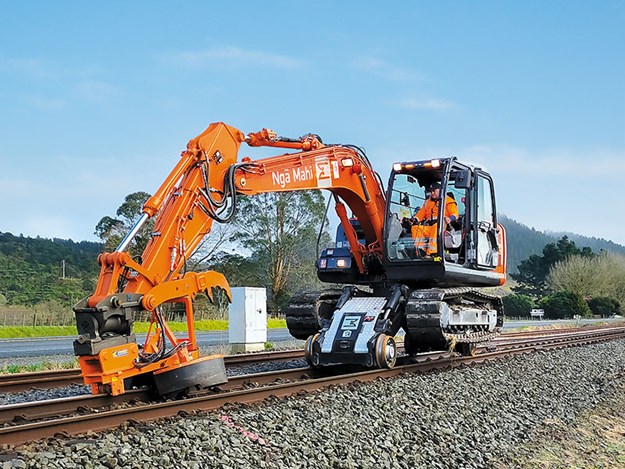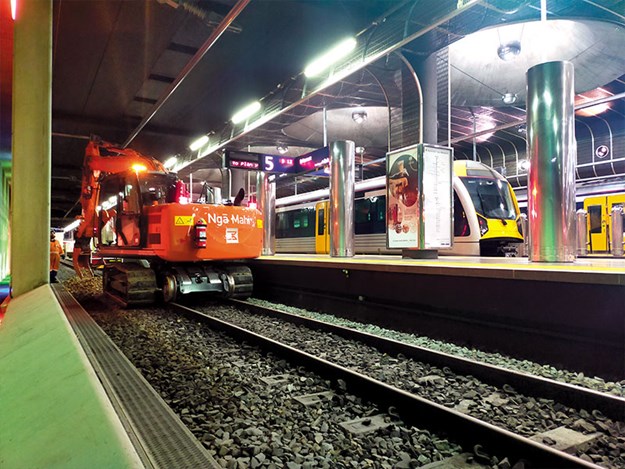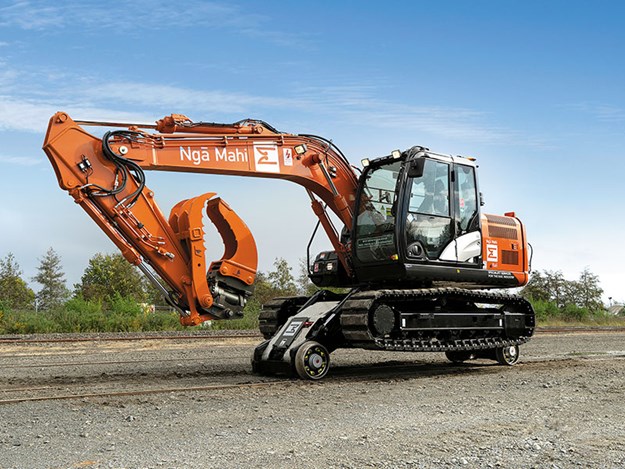Special feature: Hitachi machines for hi-rail work
A new entrant to hi-rail work has coupled Hitachi machinery with first in NZ technology to provide a safe environment for their operators and workers on job sites
Investing in equipment built for rail work takes considerable courage or guts as it’s more commonly known. But that’s exactly what new player Nga Mahi Ltd has done with the introduction of three new hi-rail excavators that they have equipped with advanced height and slew technology along with a host of other operating features, all designed to keep people safe.
Guts, I hear you say. Why does it take guts to do hi-rail work? Well, without even mentioning there’s only one customer in town, thought must be given to the eye-watering cost of building a machine, let alone three, to align with Kiwi Rail’s 80-something paged Hi-Rail Vehicle Code.
Next off, if you’re working a machine anywhere electric trains operate in Auckland or the Central North Island, there’s 25,000 volts sitting in those overhead cables. It’s only 1500 volts in the greater Wellington area so you get off a bit lighter, but it’s still enough to potentially fry you and the digger, as well as creating a spectacular but dangerous fireworks display. And what’s more, is that you don’t even have to touch a cable; getting close is good enough to make the next hourly news bulletin.
But more than anything else, with only one customer (and probably why players in hi-rail work are relatively few) is that one mistake could potentially mean the end of a business.
The machines
 |
|
CablePrice has supplied three excavators to Nga Mahi Ltd for hi-rail work
|
Going along with the hi-rail technology, Nga Mahi selected Hitachi ZX130-5B excavators to supply the hydraulic muscle with significant custom work undertaken to have the three excavators fitted out and all compliant for hi-rail work.
"We looked at a number of different brands, finally deciding on Hitachi, as they were able to supply the best machine for the work with good power on tap," says Chris
Sklenars, Nga Mahi Ltd national operations manager. "CablePrice were able to deliver us what we wanted when we needed it."
The standard grousers on the machine have been swapped out with narrower 500mm grousers and fitted with rubber pads to enable the machines to be able to walk across the rails and straddle the tracks without damaging the rail or the sleepers.
"Five years ago, the majority of machines on the rail were 11 tonnes and now you’re looking at 13 or 14 tonnes," says Chris. "The heavier machines start pushing the limits of the rail gear, forcing us to beef up the rail gear itself to ensure every part of the machine is up for the task."
Height and slew technology
 |
|
Rubber pads have been fitted to prevent damage to sleepers and rail tracks
|
As I see it, what puts Nga Mahi in an enviable position for work going forward is they took a step forward with the introduction of height and slew technology that was developed in the UK for Network Rail.
Built for safe working under live wires and beside rail tracks, Nga Mahi says Version 8 of the technology has been in existence for seven years with zero recorded failures.
"We saw this technology as a game changer for the type of work the business was getting into and went through a significant evaluation process before it was approved for use as a secondary form of protection with work ongoing," says Chris.
A basic description of the system allows for height limits (invisible ceiling), slew limits, invisible walls, and load exceedance limiting when working in hi-rail mode.
"For us, there was really no ifs and buts when looking at the installation of the technology. Yes, putting such equipment in place is expensive, but we wanted to ensure our people and those working alongside the machinery were protected as much as possible, and this gives us the confidence that people are protected in what can sometimes be dangerous environments," Chris says.
Gravity and proximity sensors
 |
|
Working on a Te Kuiti rail crossing
|
A big part of the technology are the gravity sensors that are mounted on the main body, dipper arm, boom, and tilt-head/bucket. These clever devices are calibrated to know the shape of the part of the excavator they are attached to, and as I understand, it communicates with each other, so the system always knows the highest and furthest point of the machine. This allows for the creation of virtual walls and ceilings and feeds live information to the operator.
For safety, two sets of sensors are installed at each mount point so if one sensor in the set fails, the system will know and prevent the machine from operating.
Proximity sensors are also fitted on the slew ring that tells the system which way the operator is slewing and provides a zero to 360-degree reading inside the cab. This is important for the load exceedance technology and allows for instances where a slew limit may be required while still maintaining full reach of the arm for example.
Operating in the real world
 |
|
On display at NZ Agricultural Fieldays® 2021
|
The entire system is controlled from inside the cab via a touchscreen, which thoughtfully can be folded away to allow better visibility.
To prevent an over-enthusiastic operator from changing a ceiling, wall, or slew limit setting just to get those last few buckets, before commencing work and once the limits have been set and locked, a safety key is passed across to the mobile plant controller or electrical safety observer. Once the limits have been set and the key removed, the settings will remain in place regardless of how many times the machine is shut down and restarted.
The system will operate in standard excavator configuration (road) or rail mode and automatically switches between the two when the hi-rail gear is raised or lowered. Additionally, the hi-rail gear will not lift the machine past a ceiling limit.
Further control over the hydraulic system allows for motion cuts and slowdowns of the excavation and slew functions ensuring smooth operating and working safely within specified parameters.
But what if something breaks down you ask? Well, with all those electronics onboard and because it’s a machine, a breakdown may eventually happen. In the case of a fault with the system or a sensor, the ‘Watchdog’ will automatically restrict movement. In the situation of a failure while working on a rail line, an override located behind a screw panel away from the operator cab will clear any lockouts and allow the machine to clear the track.
Other features
 |
|
The bucket and attachments can fold up under the arm
|
For anyone thinking about investing in hi-rail equipment, the list goes on with 700mm having been taken out of the height of each excavator, along with a low-profile tilt actuator and buckets.
"We went through a lengthy process with the bucket and attachment manufacturer to reduce the tip radius of the buckets, which you will notice is designed to completely fold up under the main boom even with the shortened dipper arm ‘stick," says Chris.
"In our case, we used local Hamilton-based companies to provide the attachments and hydraulic fit-outs. The talent we have in the Waikato is phenomenal, and we wanted to harness that in the hope that we can establish a hi-rail specialist build hub in the area.
"It’s all about delivering the lowest-profile machine we can that will operate safely and efficiently. That I’m confident we’ve done with the help of CablePrice and our other suppliers. It all fits with who we are and what we are about."
For more information, visit cableprice.co.nz.
Find new and used loaders for sale in NZ
Keep up to date in the industry by signing up to Deals on Wheels' free newsletter or liking us on Facebook.







.jpg)
.jpg)
.jpg)
-(1).jpg)
.jpg)

